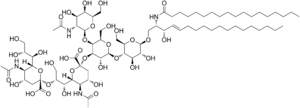GD2
 | |
| Names | |
|---|---|
| IUPAC name
(2R,4R,5S,6S)-2-[3-[(2S,3S,4R,6S)-6-[(2S,3R,4R,5S,6R)-5-[(2S,3R,4R,5R,6R)-3-acetamido-4,5-dihydroxy-6-(hydroxymethyl)oxan-2-yl]oxy-2-[(2R,3S,4R,5R,6R)-4,5-dihydroxy-2-(hydroxymethyl)-6-[(E)-3-hydroxy-2-(octadecanoylamino)octadec-4-enoxy]oxan-3-yl]oxy-3-hydroxy-6-(hydroxymethyl)oxan-4-yl]oxy-3-amino-6-carboxy-4-hydroxyoxan-2-yl]-2,3-dihydroxypropoxy]-5-amino-4-hydroxy-6-(1,2,3-trihydroxypropyl)oxane-2-carboxylic acid | |
| Other names
Ganglioside G2 | |
| Identifiers | |
3D model (JSmol) |
|
PubChem CID |
|
| |
| Properties | |
| C74H134N4O32 | |
| Molar mass | 1,591.88 g·mol−1 |
Except where otherwise noted, data are given for materials in their standard state (at 25 °C [77 °F], 100 kPa). | |
| Infobox references | |
GD2 is a disialoganglioside expressed on tumors of neuroectodermal origin, including human neuroblastoma and melanoma, with highly restricted expression on normal tissues, principally to the cerebellum and peripheral nerves in humans.
The relatively tumor specific expression of GD2 makes it a suitable target for immunotherapy with monoclonal antibodies or with artificial T cell receptors.[1] An example of such antibodies is hu14.18K322A, a monoclonal antibody. This anti-GD2 antibody is currently undergoing a phase II clinical trial in the treatment of previously untreated high risk neuroblastoma given alongside combination chemotherapy prior to stem cell transplant and radiation therapy.[2] A prior phase I clinical trial for patients with refractory or recurrent neuroblastoma designed to decrease toxicity found safe dosage amounts and determined that common toxicities, particularly pain, could be well managed. [3]
See also
References
- ↑ Wierzbicki, Andrzej; Gil, Margaret; Ciesielski, Michael; Fenstermaker, Robert A.; Kaneko, Yutaro; Rokita, Hanna; Lau, Joseph T.; Kozbor, Danuta (2008). "Immunization with a Mimotope of GD2 Ganglioside Induces CD8+ T Cells That Recognize Cell Adhesion Molecules on Tumor Cells". Journal of Immunology. 181 (9): 6644–6653. doi:10.4049/jimmunol.181.9.6644. PMC 2730120. PMID 18941255.
- ↑ "Clinical trials using anti-GD2 monoclonal antibody hu14.18K322A". National Cancer Institute. Retrieved April 20, 2018.
- ↑ Navid F, et al. (May 2014). "Phase I trial of a novel anti-GD2 monoclonal antibody, Hu14.18K322A, designed to decrease toxicity in children with refractory or recurrent neuroblastoma". Journal of Clinical Oncology. 32 (14): 1445–52. doi:10.1200/JCO.2013.50.4423. PMC 4017710.
2. Engineering anti-GD2 monoclonal antibodies for cancer immunotherapy. Ahmed M, Cheung NK. FEBS Lett. 2014 Jan 21;588(2):288-97
3. Neuroblastoma: developmental biology, cancer genomics and immunotherapy. Cheung NK, Dyer MA. Nat Rev Cancer. 2013 Jun;13(6):397-411